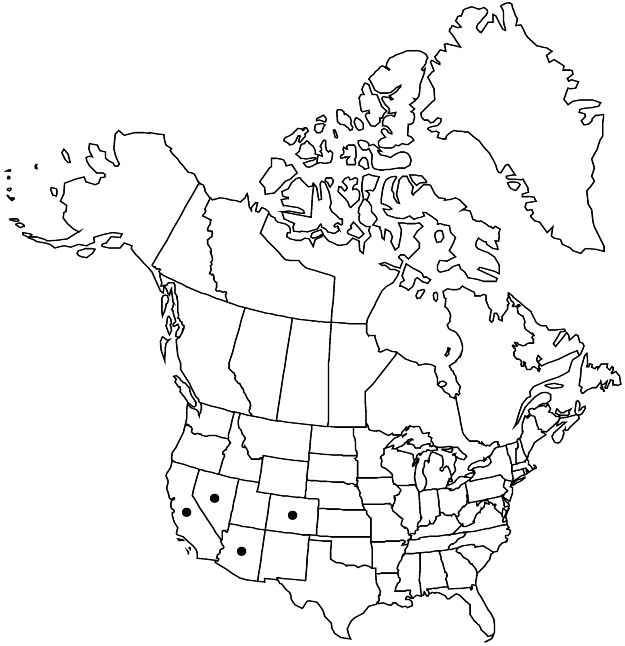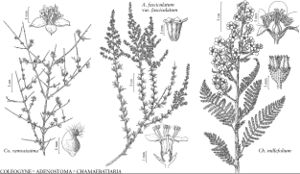Coleogyne ramosissima
Smithsonian Contr. Knowl. 6(2)[as 5(1)]: 8, plate 4. 1853.
Stems strigose, medifixed hairs to 0.5 mm; internodes 1–2 cm, short-shoot spurs to 7 mm, 1 mm thick. Leaves: 0.4–1(–1.2) mm, base clasping; stipules acute, free portion 0.2–0.5 mm; blade 3-angled in cross section, 0.6–1.4 mm wide, abaxially 5-ribbed, apex acute, surfaces strigose. Flowers: sepals ovate to broadly ovate or obovate, concave-convex, 5–7 mm, outer pair acuminate, inner cuspidate, abaxially red-green, strigose, adaxially yellow to orange-yellow, glabrous; petals, if present, 5–8 mm; stamens borne between sepals and on proximal 1/2 of torus sheath, filaments yellow, 5–8 mm; torus sheath light yellow, tubular, narrowly obconic, 4–6(–9) mm, thick-membranous, exterior glabrous, interior long-sericeous proximally, hair tips slightly protruding from orifice of sheath; styles 5–6 mm, slender, stigmas 3–5 mm. Achenes red-brown. 2n = 16.
Phenology: Flowering Apr–May; fruiting Jun–Oct.
Habitat: Arid scrub zones, Great Basin and Mojave deserts, pinyon-juniper, Joshua tree woodlands
Elevation: (300–)900–1800(–2400) m
Distribution

Ariz., Calif., Colo., Nev., Utah
Discussion
In the Great Basin and Mojave deserts, Coleogyne ramosissima is the dominant shrub in areas of shallow soils underlain by a caliche layer (S. A. Lei and L. R. Walker 1997). In deeper soils, grasses and other shrubs prevent dominance by C. ramosissima. The species has a notably long life span; seedling establishment is rare in arid sites but is more likely at higher elevations and in cooler portions of the species's range (R. H. Webb et al. 1987; S. E. Meyer and B. K. Pendleton 2005).
In some areas Coleogyne ramosissima provides important cover and winter browse for mule deer and desert bighorn sheep (D. L. Jeffries and J. M. Klopatek 1987). It is used to a much lesser extent by domestic livestock. B. K. Pendleton and R. L. Pendleton (1998) show the species is wind pollinated.
Selected References
None.
